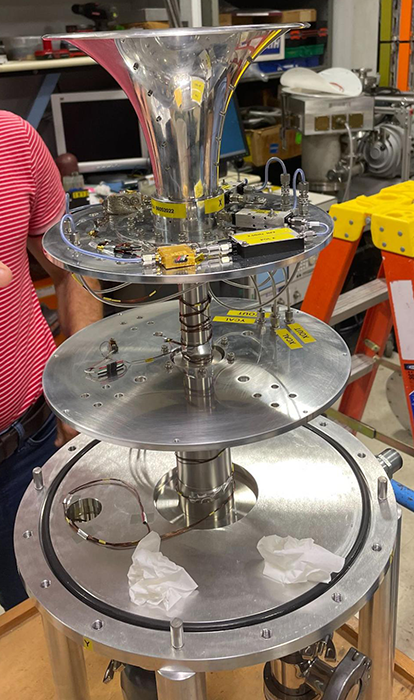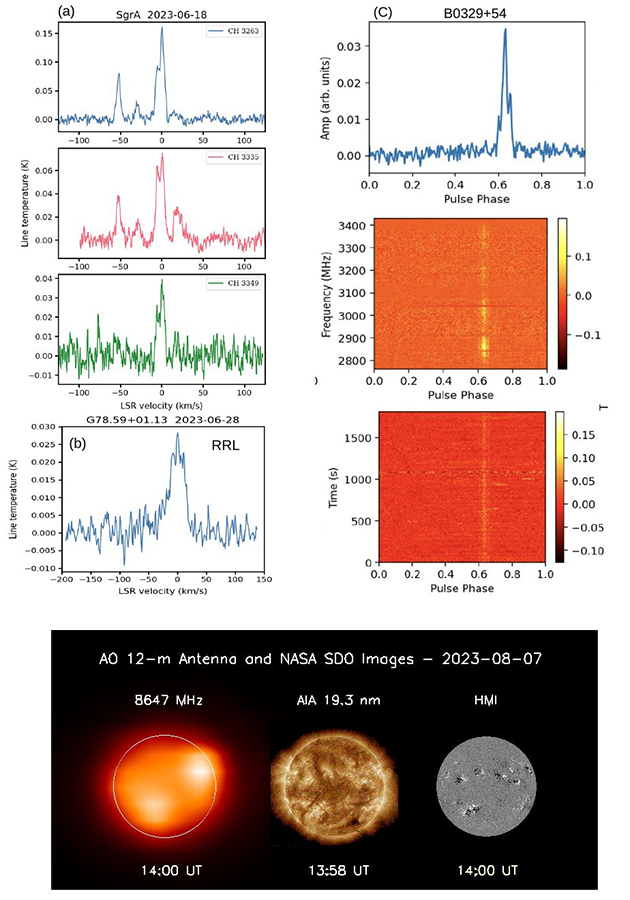The Cryogenic Wideband (2.5 - 14 GHz) Receiver System for the Arecibo 12m Telescope
The Arecibo Observatory, in addition to the now-decommissioned 305-meter radio dish, hosts a 12-meter radio dish telescope. Following the collapse of the 305-m telescope, its backend receivers were re-purposed for use with the 12-m telescope, broadening the scientific capabilities of the smaller dish.
The 12-m telescope was commissioned in 2011 with room-temperature receivers operating at S-band (2.21 - 2.34 GHz) and X-band (8.1 - 9.2 GHz). In more recent years, it was fitted with the appropriate backend to be used as a part of the Very Long Baseline Interferometer (VLBI) and was used extensively to image the solar radio continuum at X-band and to monitor pulsars at high-cadence at S-band.
However, the operation of the 12-m at room-temperature and its relatively narrow bandwidth were not appropriate for many other astronomical applications. In 2021, the team at AO began the process of upgrading the telescope with a wideband (2.5-14 GHz) cryogenic front end receiver. This massive effort was undertaken by AO scientists, engineers, and staff, including: Anish Roshi, Phil Perillat, Felix Fernandez,, Bentege Perera, P.K. Manoharan, Luis Quintero, Arun Venkataraman, Sravani Vaddi, Allison Smith, Carlos Rios, Wilson Morales, Francisco Jimenez, and Osvaldo Colon. The cryostat, wideband feed and cooled receivers were designed and built by Hamdi Mani, CryoElec, Arizona, in consultation with the AO team.

The first phase of the upgrade was completed in early 2022, and Phase II of the project began in the summer of 2022. Commissioning was completed mid-2023, with first light acquired in late June. The receiver temperature measured at the outdoor antenna facility was ~25K over 2.5 GHz to 14 Ghz. The zenith system temperature measured on the 12-m telescope was about 40K near 3.1 and near 8.6 GHz.

In the six weeks between the completion of the upgrade and the closure of the Arecibo Observatory, the team of AO scientists acquired as much astronomical science data as possible. Many of these observations were conducted in part by undergraduate students from the ENCANTO program at the Arecibo Observatory.
Tracing Low-Density Molecular Gas: One of the primary projects was to observe emission lines from Methylidyne (CH) in the galactic plane. CH has three transition frequencies that are accessible with the upgraded system at 3.263 GHz, 3.335 GHz and 3.349 GHz. This molecule was chosen because it can serve as a tracer for low-density molecular gas, which is not traceable using CO emissions.
Extended Ionized Gas in Cygnus X: The upgraded 12-m telescope was able to detect radio recombination lines from Cygnus X region, which originate from extended ionized gas in the region. This data set is used to investigate the yet unexplained lack of helium ionization in the extended gas.
Pulsar Observations: The 12-m telescope with the new receiver was used to continue the high-cadence pulsar monitoring program. These observations were done near 3.1 GHz.
Solar Imaging: On Aug 7, 2023, the upgraded 12-m telescope imaged the Sun at X-band. Near-simultaneous images were acquired in the extreme ultraviolet by the Solar Dynamics Observatory. The radio images show an active region of complex magnetic configuration on the Sun that produces intense flares and coronal mass ejections.
These planned areas of science and the future science that could be accomplished using the 12-m telescope following the vast improvements provided by the upgraded cryogenic system, are captured in the Bulletin of the AAS article published by AO staff Anna McGilvray.
A detailed description of the cryogenic frontend upgrade, future work that should be done to further improve the facility, and the results from the commissioning observations will be published in an upcoming article in Radio Science, led by Anish Roshi, Head of Astronomy at AO (Roshi et al. 2023).
This massive, important effort demonstrates the unique science capabilities still achievable at the Arecibo Observatory.
